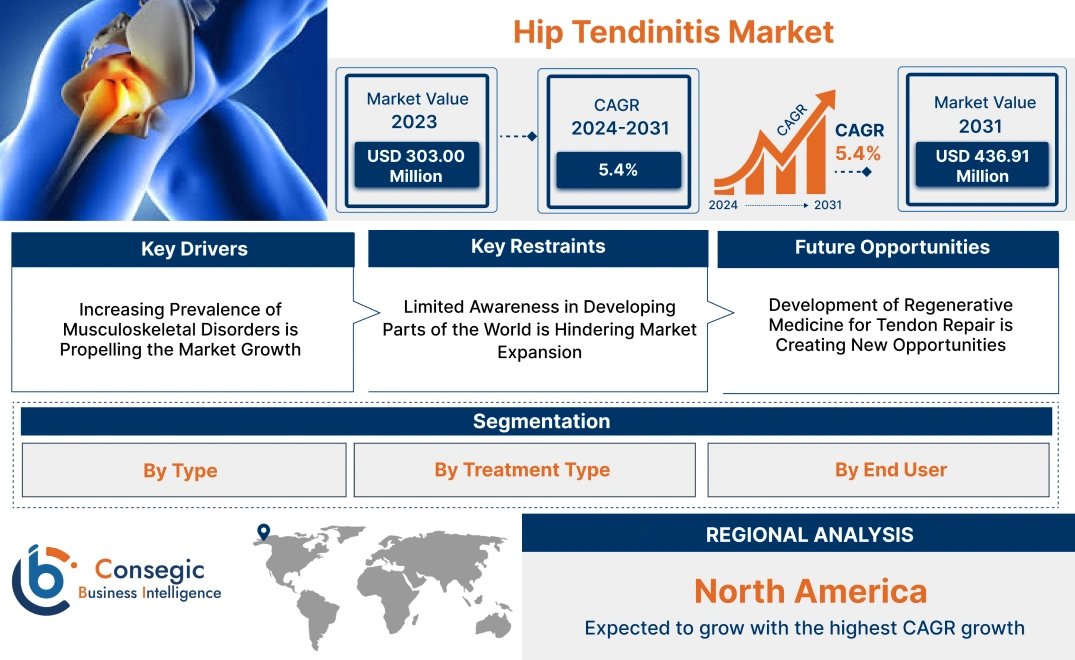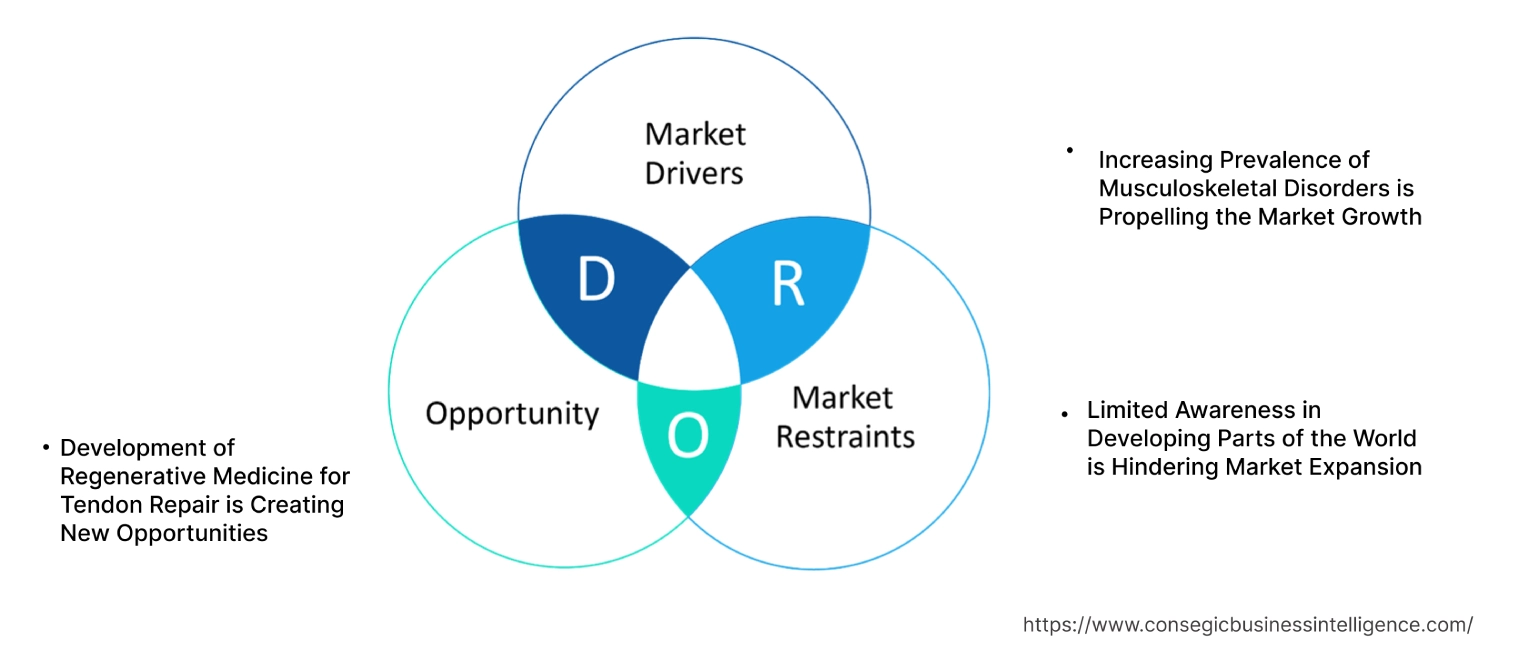- Summary
- Table Of Content
- Methodology
Hip Tendinitis Market Size:
Hip Tendinitis Market size is growing with a CAGR of 5.4% during the forecast period (2024-2031), and the market is projected to be valued at USD 436.91 Million by 2031 from USD 303.00 Million in 2023.
Hip Tendinitis Market Scope & Overview:
Hip tendinitis, more commonly known as hip tendonitis, refers to an inflammation of the tendons that surround the hip joint's area. This common health condition occurs due to repetitive use of the hip or endless activities. This condition is prevalent among athletes or people with physique professions with involving fluid hip movements like the runners, cyclists, or dancers. Doing a new exercise program improperly or going at it too fast damages the tendons, and causes tendinitis. The primary end users are the patients undergoing hip tendinitis. It involves pain control, restoration of functioning as well as ongoing care regarding their illness.
Hip Tendinitis Market Insights:
Key Drivers:
Increasing Prevalence of Musculoskeletal Disorders is Propelling the Market Growth
The rise in the incidence of musculoskeletal disorders is a key factor influencing the different healthcare segments such as tendinitis of the hip and its treatment. With the increasing number of people of working age across the world, the prevalence of musculoskeletal dispositions like arthritis, tendinitis, and back aches rises. The aging process wears out joints and muscles making the elderly more susceptible to these conditions. With increasing instances of musculoskeletal disorders, an increase in the use of healthcare structures is realized, especially in diagnosis, treatment, and rehabilitation. This includes visits to orthopedists, physical therapists, and many other specialists involved in the care of these problems. Manufacturers of rehabilitation and physical therapy equipment expect more consumers because of the increasing elderly population.
- In July 2022, WHO stated that approximately 1.71 billion people have musculoskeletal conditions worldwide. Musculoskeletal impairments include about 150 different diseases/conditions that affect the system and are distinguished by impairments in the muscles, bones, joints, and associated connective tissues.
Therefore, the market trends analysis shows that the increasing prevalence of musculoskeletal disorders is a significant factor influencing various sectors within the healthcare industry.
Key Restraints :
Limited Awareness in Developing Parts of the World is Hindering Market Expansion
The challenges that are evident in the developing regions are the low levels of understanding about the disorder and symptoms of hip tendinitis among the population and the medical profession. The developing regions suffer from poor resource endowment, especially in health, and limited access to modern technologies and procedures like Regenerative Medicine and other minimally invasive surgeries. It affects the availability as well as the use of modern therapies for hip tendinitis. Unclear or negligible developments in healthcare policies in some areas affect the implementation of such strategies in standard care practices. Therefore, limited awareness in developing regions is a significant restraint impacting the hip tendinitis market demand.
Future Opportunities :
Development of Regenerative Medicine for Tendon Repair is Creating New Opportunities
Stem cell-based therapies or regenerative medicine, which encompasses new therapeutic methods based on the idea of repairing damaged tissues, is still a burgeoning field and could offer the possibility of delivering improved and durable treatments. Stem cell therapy is one of the key approaches in regenerative medicine. It is possible to employ stem cells to fix disabled tendons to increase the rates of recovery and regain function. Some research on mesenchymal stem cells, as well as other stem cell sources, is pointing towards enhanced tendon repair and decreased healing time. Subsequent therapies will integrate several regenerative strategies: stem cell therapy in conjunction with biomaterial scaffolds or gene therapy to improve the condition of tendon repair.
- According to an article published by Mayo Clinic in March 2024, regenerative medicine, also known as stem cell treatment uses stem cells or their derivatives to promote the healing of damaged or diseased tissue. It helps in organ transplantation as it uses cells instead of the donor's organ which remains limited sometimes.
Therefore, as per the market analysis, the development of regenerative medicine for tendon repair presents significant future hip tendinitis market opportunities, offering the potential for more effective and personalized treatments.
Hip Tendinitis Market Segmental Analysis :
By Type:
Based on type the market is segmented into Internal Snapping Hip, External Snapping Hip, and Intra-articular Snapping Hip.
Trends in the Type:
- Nonsteroidal anti-inflammatory drugs (NSAIDs) and corticosteroid injections are used to manage pain and inflammation, contributing to market revenue.
- Advancements in orthopedic treatments, including minimally invasive surgical techniques and regenerative medicine, are contributing to the growth of this segment.
The external snapping hip segment accounted for the largest revenue of the total hip tendinitis market share in 2023.
- External Snapping Hip is a condition that occurs when a tendon or muscle slides over a bony prominence on the outer side of the hip, causing a snapping or popping sensation. It is often associated with the iliotibial band or the gluteus maximus tendon.
- Repetitive activities or overuse, particularly in athletes and individuals involved in running or jumping sports, leads to external snapping hip.
- Physical therapy, including stretching and strengthening exercises, is a common treatment for external snapping hips. The demand for such therapies drives revenue in this segment.
- For instance, as per the Hospital for Special Surgery, dancers, runners, soccer players, and weightlifters are particularly prone to breaking hips as they're continually putting their hips in flexion.
- Thus, as per the segmental trends analysis, factors such as the growing demand for physical therapy, advancements in diagnostics and treatments, and the focus on sports medicine contribute to hip tendinitis market demand.
The intra-articular snapping hip segment is anticipated to register the fastest CAGR during the forecast period.
- Intra-articular snapping Hip is a condition that occurs within the hip joint itself, such as a torn labrum or loose body, causing a snapping or popping sensation.
- The development and improvement of diagnostic tools such as MRI and arthroscopy have enhanced the ability to detect intra-articular snapping hips. Improved imaging techniques lead to more accurate diagnoses and, consequently, increased treatment interventions.
- Emerging treatments like stem cell therapy and platelet-rich plasma (PRP) injections are gaining popularity for their potential to repair damaged cartilage and improve outcomes in intra-articular snapping hip cases.
- For instance, MedFin states that hip arthroscopy is performed to address intra-articular conditions including labral tears or loose bodies that cause the hips to break.
- Thus, as the market evolves, ongoing research and technological innovations are expected to further drive the hip tendinitis market trends.
By Treatment Type:
Based on treatment type the market is segmented into Medications (Nonsteroidal Anti-Inflammatory Drugs (NSAIDs)), Corticosteroids and Analgesics, Physical Therapy, Surgery (Tendon Repair Surgery), Tendon Debridement, and others.
Trends in the Treatment Type:
- NSAIDs are effective in providing symptomatic relief, which drives high usage rates and, consequently, significant revenue.
- The integration of emerging technologies such as robotics, augmented reality, and AI in surgery could enhance precision and outcomes, supporting rapid growth.
The medications (NSAIDs) application accounted for the largest revenue of the total hip tendinitis market share in 2023.
- NSAIDs are a class of drugs that provide relief from pain, reduce inflammation, and lower fever. Common examples include ibuprofen, naproxen, and aspirin.
- NSAIDs are frequently used to manage pain and inflammation associated with musculoskeletal disorders, including hip tendinitis. They work by inhibiting enzymes (COX-1 and COX-2) involved in the inflammatory process.
- They are often used in combination with other therapies, such as physical therapy or corticosteroids, enhancing their utilization and revenue generation.
- For instance, nonsteroidal anti-inflammatory medicines (NSAIDs) are the most commonly used medications to relieve the pain, inflammation, and stiffness associated with arthritis, bursitis, and tendonitis.
- Thus, NSAIDs accounted for the largest revenue in the medications segment due to their widespread use, effectiveness in managing pain and inflammation, and accessibility, thus, in turn, boosting the hip tendinitis market trends.
The surgery (tendon repair surgery) segment is anticipated to register the fastest CAGR during the forecast period.
- Tendon repair surgery aims to restore the function of the affected tendon and alleviate pain.
- With a growing number of people engaging in physical activities, sports, and exercise, tendon injuries are becoming more common. This trend drives demand for surgical interventions to address severe or chronic cases.
- Newer techniques and technologies in tendon repair surgery result in faster recovery times, improved functional outcomes, and lower complication rates. These factors increase patient and physician preference for surgical options over conservative treatments.
- For instance, arthroscopic excision of the bursa is a relatively recent treatment that is gaining popularity. This procedure involves making a tiny incision over the hip to remove the bursa. This surgery is less invasive, and recovery is quicker and less painful.
- Thus, as the field continues to evolve, the integration of new technologies and approaches will likely sustain the rapid expansion of the tendon repair surgery segment, boosting the hip tendinitis market expansion.
By End-User:
Based on end-user the market is segmented into Hospitals, Specialty Clinics, Physiotherapy Centers, Ambulatory Surgery Centers (ASCs), and Home Care Settings.
Trends in the End-User:
- Many hospitals offer in-house rehabilitation services, which are crucial for recovery following treatment for hip tendinitis. This includes physical therapy sessions and other supportive therapies.
- Ongoing advancements in surgical techniques, including robotic-assisted surgery and enhanced imaging, contribute to the growth of ASCs by expanding the range of procedures they offer.
The hospital segment accounted for the largest revenue share of 43.28% in the year 2023.
- Hospitals are equipped with sophisticated diagnostic technologies such as MRI, ultrasound, and X-rays, essential for accurately diagnosing hip tendinitis and assessing its severity.
- For cases that require surgical intervention, hospitals offer advanced surgical procedures such as arthroscopic tendon repair, which are not always available in other healthcare settings.
- For instance, Apollo Hospital states that to diagnose hip bursitis, the doctor performs a thorough physical examination by imaging examinations such as x-rays, bone scans, and magnetic resonance imaging (MRI).
- Thus, the hospital application segment accounted for the largest revenue share in the treatment of hip tendinitis due to their comprehensive treatment facilities, multidisciplinary approach, and ability to manage both acute and chronic cases, driving the hip tendinitis market growth.
The ambulatory surgery centers (ASCs) segment is anticipated to register the fastest CAGR during the forecast period.
- Ambulatory Surgery Centres are healthcare facilities that perform surgical procedures on an outpatient basis. Patients undergo surgery and are typically discharged on the same day without the need for an overnight hospital stay.
- Patients and providers increasingly prefer minimally invasive procedures that often result in shorter recovery times, lower costs, and reduced hospital stays.
- For instance, common procedures in ASCs include cataract surgery, gallbladder removal, tonsillectomy, endoscopy/colonoscopy, and arthroscopic/orthopedic procedures, with cardiology being the fastest-growing specialty.
- Thus, as per the segmental analysis, the ambulatory surgery centers segment is expected to register the fastest due to their cost-effectiveness, operational efficiency, and the growing preference for outpatient surgical procedures, thus, in turn, driving the hip tendinitis market opportunities.
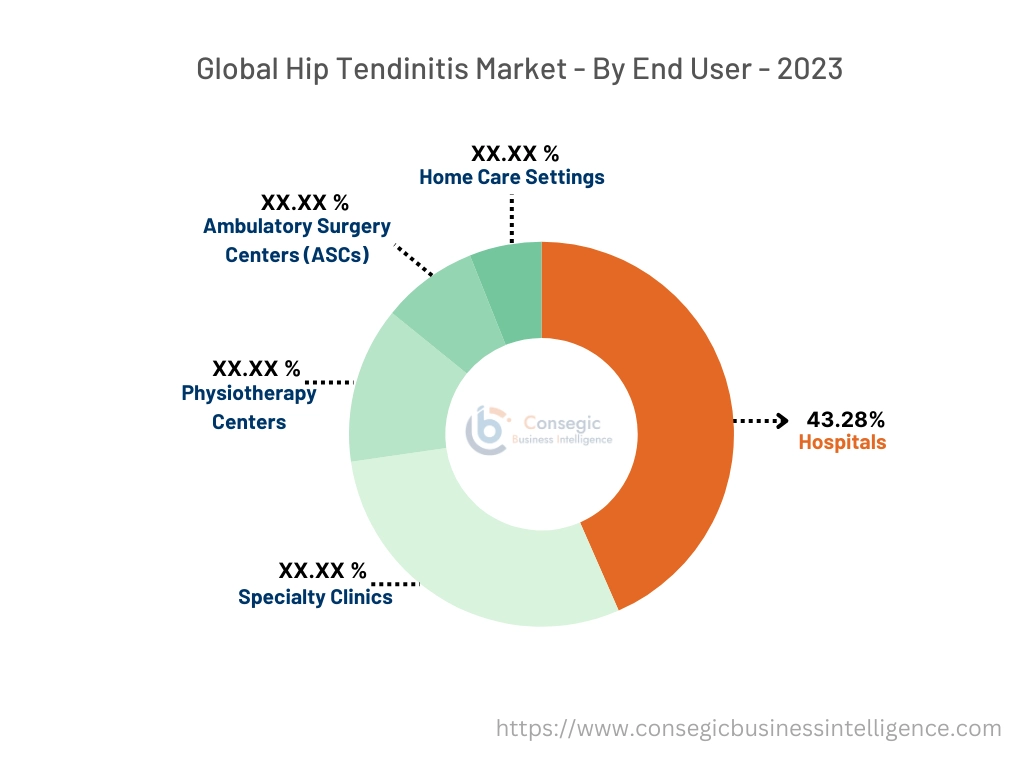
Regional Analysis:
The regions covered are North America, Europe, Asia Pacific, the Middle East and Africa, and Latin America.
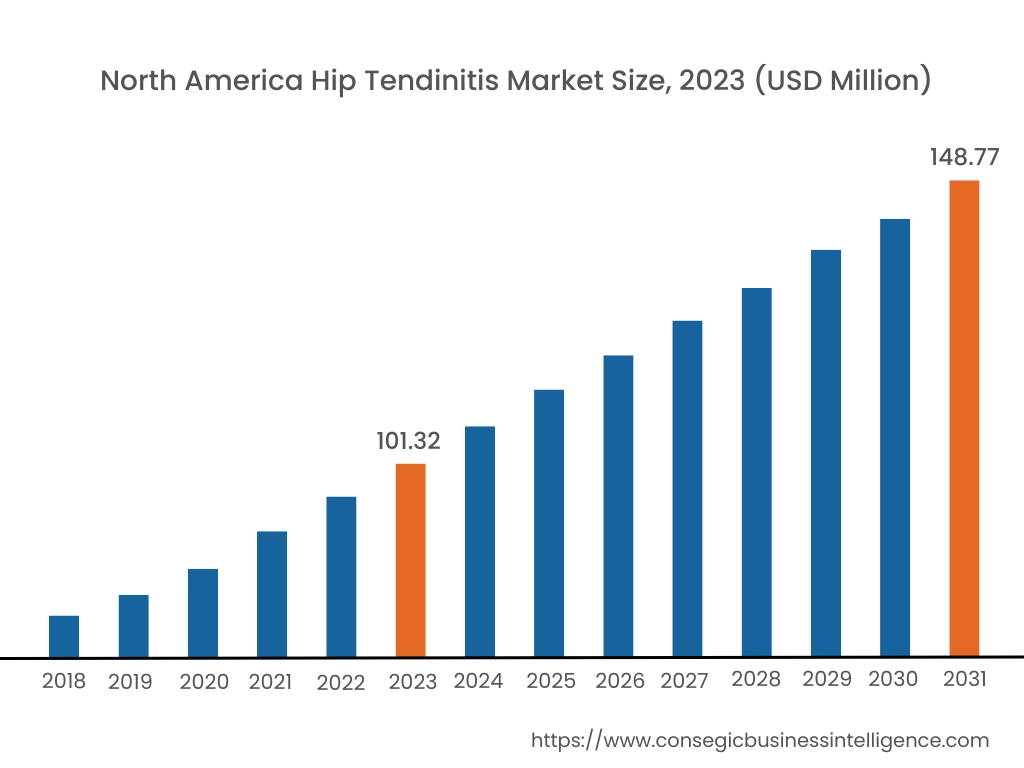
In 2023, North America accounted for the highest market share at 33.44% and was valued at USD 101.32 Million, and is expected to reach USD 148.77 Million in 2031. In North America, the U.S. accounted for the highest market share of 66.01% during the base year of 2023. As per the hip tendinitis market analysis, North America boasts advanced healthcare facilities, including hospitals, outpatient surgery centers, and specialized clinics, equipped with cutting-edge technology for diagnosing and treating hip tendinitis. The adoption of minimally invasive surgical techniques, such as arthroscopy, is prevalent in North America, improving patient outcomes and recovery times.
- In 2024, Tenex tenotomy is a non-surgical therapy designed to alleviate persistent pain caused by tendinitis, tendinopathy, and plantar fasciitis. The minimally invasive treatment uses high-frequency ultrasonic energy to break down and remove damaged tissues, hence reducing tendon pain.
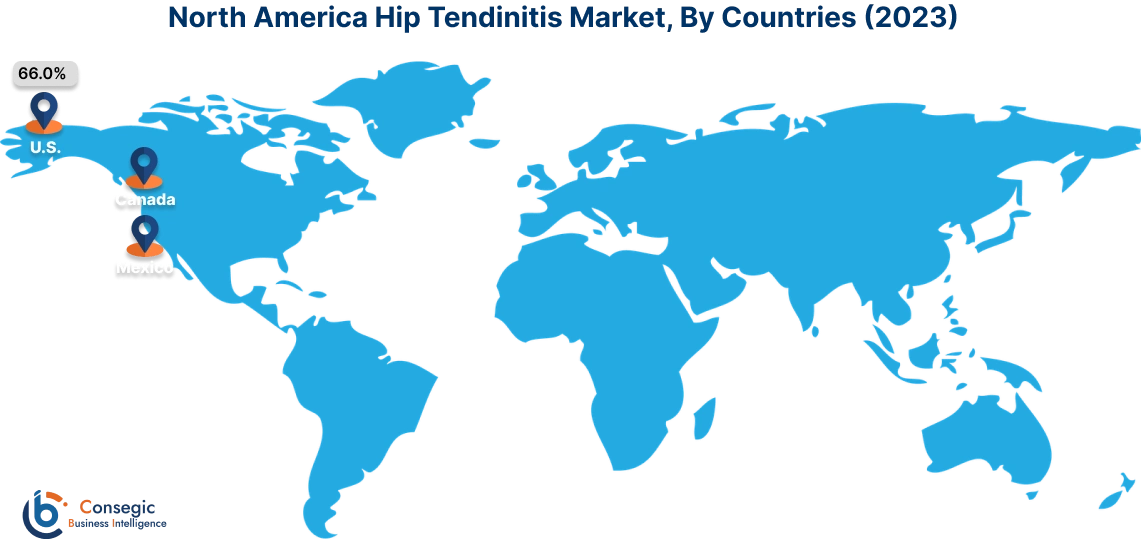
Asia Pacific is expected to witness the fastest CAGR over the forecast period of 5.9% during 2024-2031. Asia Pacific countries like India, Thailand, and Singapore are popular destinations for medical tourism, attracting patients seeking advanced treatments at competitive costs. This trend boosts the market for specialized treatments, including those for hip tendinitis.
The hip tendinitis market analysis in Europe shows that the market is poised for notable growth, driven by a combination of demographic, economic, and healthcare system factors. Innovative treatments, including stem cell therapy and platelet-rich plasma, are increasingly utilized in Europe. The Middle East and Africa market for hip tendinitis treatment is experiencing growth due to the increasing adoption of advanced diagnostic and treatment technologies, such as minimally invasive surgical techniques and regenerative medicine, which is improving treatment outcomes for hip tendinitis. Latin America is emerging as a destination for medical tourism, with countries like Brazil and Mexico attracting patients seeking affordable and advanced treatments for musculoskeletal conditions, including hip tendinitis.
Top Key Players & Market Share Insights:
The hip tendinitis market is highly competitive with major players treatments to the national and international markets. Key players are adopting several strategies in research and development (R&D), product innovation, and end-user launches to hold a strong position in the global hip tendinitis market. Key players in the hip tendinitis industry include –
- Pfizer Inc. (USA)
- GSK plc. (UK)
- Novartis Pharmaceuticals Corporation (Switzerland)
- Teva Pharmaceutical Industries Ltd. (Israel)
- Bayer AG (Germany)
- Sanofi S.A. (France)
- Johnson & Johnson Inc. (USA)
- AstraZeneca plc (UK)
- Merck & Co., Inc. (USA)
- AbbVie Inc. (USA)
Recent Industry Developments :
Mergers & Acquisitions:
- In January 2023, Zimmer Biomet Holdings Inc. acquired Embody Inc. a medical device business focused on soft tissue healing. Collagen-based bio-integrative will be offered to assist healing in the most difficult orthopedic soft tissue injuries.
Partnerships & Collaborations:
- In September 2024, Medacta Group SA formed a partnership with Think Surgical Inc. to provide robotic total knee replacement solutions. They would bring together Think Surgical's TMINI small robotic TKR system and Medacta's digital technologies portfolio.
Hip Tendinitis Market Report Insights :
| Report Attributes | Report Details |
| Study Timeline | 2018-2031 |
| Market Size in 2031 | USD 436.91 Million |
| CAGR (2024-2031) | 5.4% |
| By Type |
|
| By Treatment Type |
|
| By End-User |
|
| By Region |
|
| Key Players |
|
| North America | U.S. Canada Mexico |
| Europe | U.K. Germany France Spain Italy Russia Benelux Rest of Europe |
| APAC | China South Korea Japan India Australia ASEAN Rest of Asia-Pacific |
| Middle East and Africa | GCC Turkey South Africa Rest of MEA |
| LATAM | Brazil Argentina Chile Rest of LATAM |
| Report Coverage |
|
Key Questions Answered in the Report
How big is the Hip Tendinitis Market? +
Hip Tendinitis Market size is growing with a CAGR of 5.4% during the forecast period (2024-2031), and the market is projected to be valued at USD 436.91 Million by 2031 from USD 303.00 Million in 2023.
Which is the fastest-growing region in the hip tendinitis market? +
The fastest-growing region in the hip tendinitis market is Asia Pacific.
What specific segmentation details are covered in the hip tendinitis market report? +
The specific segments that are covered in the hip tendinitis market are type, treatment type, and end-user.
Who are the major players in the hip tendinitis market? +
The major players in the hip tendinitis market are Pfizer Inc. (USA), GlaxoSmithKline plc (UK), Novartis AG (Switzerland), Sanofi S.A. (France), Teva Pharmaceutical Industries Ltd. (Israel), Johnson & Johnson Inc. (USA), Bayer AG (Germany), Merck & Co., Inc. (USA), AbbVie Inc. (USA), and AstraZeneca plc (UK).
